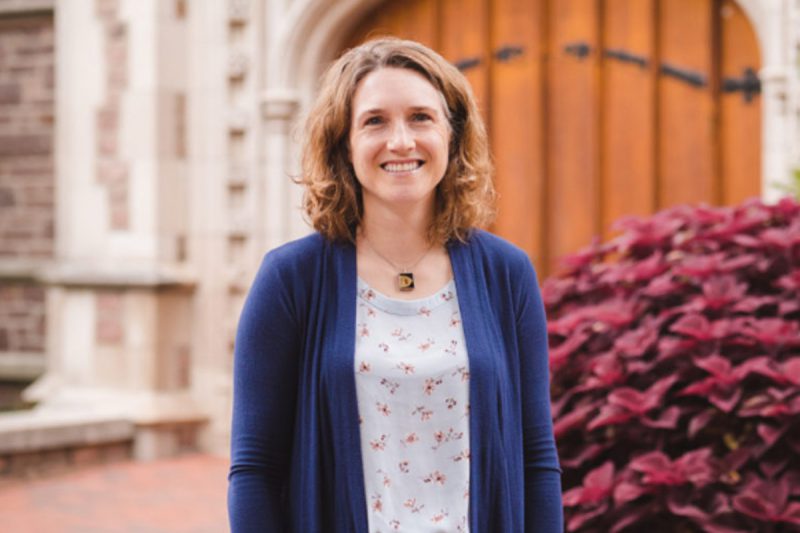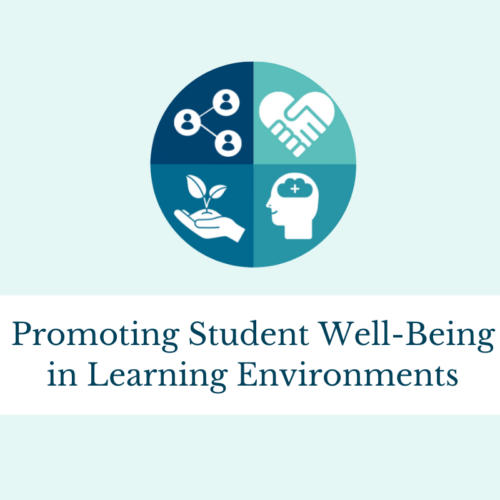
Environmental Studies Professor Emphasizes Inclusivity in STEM Courses
“I try to create a space where everyone can show up as their full selves, and where every student has a chance to have a meaningful learning experience,” said Eleanor Pardini, Ph.D., Assistant Director of Environmental Studies and Senior Lecturer at Washington University in St. Louis. Professor Pardini teaches undergraduate courses including Introduction to Environmental Biology, Introduction to Ecology, a seminar on graduate student professional development, and a seminar on the science of science communication called “Beyond the Evidence.” She also mentors undergraduate students on ecology research and graduate students in pedagogy.
Professor Pardini studies population dynamics of rare and invasive plants. Her long-term research is on threats to an endangered plant and ecosystem restoration in coastal sand dunes at the Point Reyes National Seashore in northern California.
Professor Pardini has a B.S. in Biology and English from The College of William & Mary. She earned her Ph.D. in Plant Biology from the University of Georgia, where she worked with Jim Hamrick to study the consequences of seed and pollen dispersal on genetic diversity in an invasive tree. Professor Pardini was awarded a UGA Excellence in Teaching Award in 2005 and participated in the Future Faculty Program with the Center for Teaching and Learning at UGA.
Professor Pardini then conducted postdoctoral research with Dr. Tiffany Knight at Washington University in St. Louis, where she studied consequences of seed dispersal, density dependence, and experimental management on the population dynamics of the invasive plant garlic mustard. She joined the Environmental Studies Program as a Lecturer in fall 2010.
In an interview with The Teaching Center, Professor Pardini highlighted the importance of active learning in STEM courses. She also emphasized how inclusive classrooms can make a difference in student learning.
How did you become interested in environmental studies?
I have loved plants for as long as I can remember. I think part of that comes from being influenced by my mom and grandfather. My mom grew up in England, and when my family was stationed with the Air Force in Germany, we had the opportunity to spend summers with my grandparents. My grandfather had books to identify everything – shells, birds, and plants. We were always outside – visiting beaches, shale cliffs, forests and fields. We took walks and I learned the names of wildflowers.
In undergrad, I knew I wanted to study the environment and plants. I participated in an immersive study abroad program in a cloud forest in Costa Rica. That was a hugely transformative experience. I came back and was serious about pursuing graduate school in ecology.
How has your research evolved over the years?
I studied plant population genetics in graduate school. I’ve since shifted more into basic plant ecology. I work with invasive and rare plants. My work now is on a rare plant in Point Reyes National Seashore. We’re working on understanding threats to a federally endangered plant that grows on sand dunes. Dune ecosystems on the west coast are highly disturbed. People have planted exotic plants that over stabilize the sand. It has allowed people to develop and farm closer to the beach, but it has disrupted wind and sand movement, over stabilized dunes, and harmed plants and animals. It’s an exciting place to work. We have a close partnership with the vegetation ecologist at the National Park Service. Each year we share our data and they use the information we learn to adjust how they are managing the dunes and the plants. Not only do we get to publish papers; we get to affect the management of plants and animals in a real ecosystem. It’s a really rewarding part of the research I do.
What was your path to becoming a professor?
I had a painful first year of grad school. I went to Costa Rica thinking that I would do my PhD research there, but it became clear that it would be difficult logistically. I went back to the University of Georgia to do my field work there. I was miserable, so I switched to a Master’s track. My advisor was someone who had worked with graduate students with very different end goals, so he was willing to support me as I was figuring out what I wanted to do. We picked a project that would be doable and interesting to me. At the end of my second year of graduate school, I took a class in the Division of Academic Enhancement with faculty who had PhDs in college reading and learning on strategic learning.. The class qualified me to teach a strategic learning seminar class that was adjunct to a large introductory biology class. It was basically teaching biology students how to become better learners. I really enjoyed that experience. It helped me know I loved teaching and I wanted to work with undergraduates. To do that I would need to earn a PhD.
Late in my third year of graduate school, my advisor supported me switching back to a PhD. I explored applying to jobs at an R1 or a teaching-oriented college. I ended up doing a postdoc at WashU with an ecologist. Almost 10 years ago, the environmental studies program here underwent some radical changes. They needed someone who could teach ecology and help steward the environmental studies program in this transition period. The job matched my passions and how I wanted to spend my time
You studied English and Biology in undergrad. How have these courses of study impacted your career?
I think I’m an interdisciplinarian at heart. In high school, I had really profound experiences with English Literature, and so I wanted to study it in college. I knew ultimately that I wanted to be a scientist, so I thought it was a gift to myself to spend time reading diverse literature and doing critical literature analysis. I loved 20th century postmodern work, medieval literature, and Faulkner. I declared both majors late even though I knew I was going to do both from day one. I didn’t know at the time, but now I see I was a better writer when I got to graduate school because of the time I spend in my literature major.
What is your perspective on inclusive teaching?
I try to explicitly make space for identity in my classes. Walking my own identity journey has been part of doing that as a faculty member. Another personal piece of that I’m more recently appreciating is that I think the experiences my brother and I had with traditional school were very different. It seems like part of it is the different experiences we had with classrooms and the traditional learning environment. Classrooms can be pretty hostile places, and there are a lot of power dynamics in the room. I’m aware of this and my classroom work is always a work on progress. I try to create a space where everyone can show up as their full selves, and where every student has a chance to have a meaningful learning experience.
What is your approach to mentoring undergraduate students?
Because I’m the assistant director of environmental studies, I often have informal conversations with students who haven’t declared a major or are still exploring. They’re searching for things to do after WashU and trying to find the best ways to prepare. I love helping students find an out-of-the box solution, or even working with them to create a new path, like a special major.
For example, there was a student in my senior thesis class who was a biology major. She had done a study abroad in her junior year on climate science and policy. She decided that she wanted to go to law school. Over a number of conversations, we decided that the biology major was constraining. She could free up some of her time to take pre-law classes if she switched into the environmental-bio major. In her senior year she was able to take the interdisciplinary environmental law clinic and one of the pre-law requirements. She then applied to and got accepted into law school.
What are some of the challenges of teaching environmental studies?
Sometimes students can be really outcomes focused. I try to build in opportunities for reflection, and for students to learn metacognitive skills. I try to balance real student concerns about their grades with teaching students how to be independent learners.
Most of the courses I’ve taught at WashU have been larger, about 60 to 100 students. I’m passionate about doing active learning and student-centered, active classes where most students will be out of their comfort zone for a little bit, but we all have a chance to engage and learn. Doing that in a large class requires logistical planning and a use of different methods. I think having a high tolerance for risk in the classroom can make doing that kind of work less intimidating.
I talk repeatedly to students about why we’re doing what we’re doing in my classes. I cite papers about active learning, and I acknowledge that it’s going to feel uncomfortable at first. Professor Kathy Miller, a retiring professor in Biology, was a mentor and source of support to stick with doing active learning in my classes. She encouraged me to keep talking to students about what we’re doing in class, and why.
How do you evaluate student learning?
I do a lot of informal assessment. That might be clicker questions or quick questions on index cards or in-class worksheets or problem sets, where I can look over shoulders to gauge how students are doing and ask them to explain their rational to me. In one of my larger classes I use two-phase exams. Students take the exam as individuals for 45 minutes, they turn it in, and then they get in groups and retake the exam for 30 minutes. The individual score is 75 percent of the grade; the group score is 25 percent of the grade. If the student’s individual grade if higher, they can keep it. Usually the group score is higher and brings everybody up.
During the group exam, the room feels very electric. Students take turn writing, they’re explaining to each other, and there’s laughter and ‘aha’ moments. It’s clear they’re learning from each other. I like that it makes the exam more of a learning opportunity.
What is one of your favorite classes to teach?
I teach a course about the science of science communication, “Beyond the Evidence.” It’s pitched at upper-level students because I want them to enter steeped in their discipline. It pulls in literature from other fields including cognitive psychology, behavioral psychology, and political science. The class started a little bit from personal interests. I was frustrated about why some of my extended family members were hesitant to get the pertussis vaccine when I had my first child. I wanted to figure out what that was, and how we could talk about it. We also discuss in class why, even though we have had evidence about climate change for decades, we haven’t had huge collective action on climate change. Why is it so hard to talk to each other about these important environmental and public health issues? How can we be more effective, empathetic, and persuasive communicators about these issues?
Who are some of your favorite teachers, and why?
Drs. Karen and Alan Masters were both PhD scientists who ran the study abroad program with CIEE in Costa Rica that I went on in undergrad. The program was really influential to me. Their classes were some of the most difficult I had encountered and I loved it all. The summer after my first year of grad school, I went back to Costa Rica to scout field sites. I visited Karen and Alan and I was talking about how difficult my first year had been. They were very kind and supportive, and I remember them telling me that most of graduate school was about perseverance. That was really meaningful at the time because it had felt so difficult, lonely, and isolating, and it meant a lot to have someone say, this is normal, it’s hard, you just have to muscle through, and you can do it.
My postdoc was the first time that I worked closely with a woman scientist who was successful and it was magical. She was super sharp, successful, strategic, and also willing to talk about family and balance. She taught me that it’s okay to be yourself, and to center your values. She also taught me how to write scientific papers.
My kids are really important teachers for me now. Becoming a parent caused a seismic period of shifting and developing for me. Part of that has been deepening my understanding of my own identity as a female scientist, a parent, and a white person, and clarifying the stories and values we care about and talk about in our family. Part of it has been learning and unlearning local and national history, and understanding where I fit into a long arc of history and organizing. Events in St. Louis, including the killing of Michael Brown, the Stockley acquittal, and local issues in my neighborhood have helped shape me and my journey. I have deepened my personal civic engagement and invested relationships and local organizing. There are incredible local leaders and organizations I look to for learning, inspiration, and guidance. Some influential spaces for me have been We Stories, YWCA’s Witnessing Whiteness, ColorBrave with City Garden Montessori, We-CAN, and Forward Through Ferguson. Identity, social justice, and equity are a way of being for me now. It’s a journey and always a work in progress.
What is your advice to aspiring instructors?
It’s good to cultivate a team of mentors, people who can see you for who you are, validate you, and lift you up. Different people might offer you different things, whether you’re finding a path as a new teacher, a graduate student or postdoc, or a young faculty member.
You have to understand the value or currency system of the place where you are. So, if you’re in a tenure-track position at a particular institution, you have to understand the currency. You have to make smart choices in ways that align with whatever currency is valued.
I’ve taught a graduate student professional development class here. It attracts people who are considering teaching careers at different types of institutions. I encourage them to be clear about their values and choose a path that aligns with those values and how they want to spend their time.



